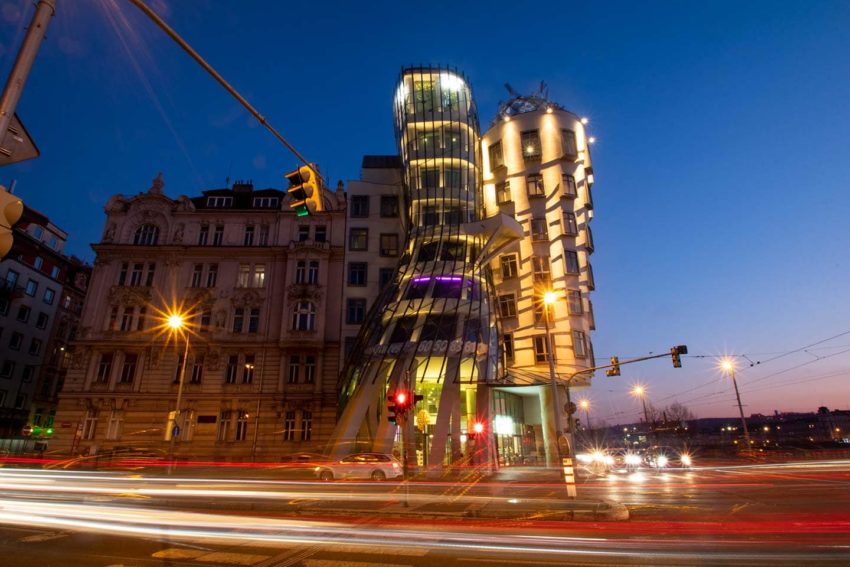The Dancing House Prague is the most famous modern building in Prague. It gained its name from its resemblance to the outline of a man and woman dancing, and has become one of the most popular stops on the Prague sightseeing circuit in recent years.
Our guide to the Dancing House tells you everything you need to know about visiting it, from its location and getting there to the café, bar, restaurant and hotel in the building. We also point you in the direction of some Prague sights within easy walking distance of the Dancing House.
Why Visit The Dancing House Prague – Tančící dům Praha


The Dancing House is one of the most iconic landmarks of Prague, and the best-known modern building in the city.
The Dancing House, like many other works by co-architect Frank Gehry, is very distinctive, its outline resembling a dancing man and woman.

It was the first significant building in Prague following the Velvet Revolution and end of the Communist regime in 1989, a daring leap into a brave new artistic world for a city best known for its vast wealth of historic architecture.
Photographing this unique building has become one of the most popular things to do in Prague because of its unusual shape. The glass section, with its narrow central part, resembles the figure of a woman.
The rooftop terrace – with views along the Vltava river and Prague Castle – is one of the best viewpoints in Prague, accessible for the reasonable price of a beer.
See Also: Prague Architecture – From Romanesque To Post-Modern
Dancing House Prague History


The Dancing House is built on the site of a former bomb patch from the Second World War.
The corner building of the block was destroyed during an Allied bombing raid which suffered something of a navigational malfunction. On 14th February 1945 some aircraft dropped their bombs on Prague rather than the intended target, the German city of Dresden.
In 1960, the rubble from the building plot was cleared but the site remained empty for decades afterwards.
A resident of the building next door, dissident playwright Václav Havel, had discussions with Czech-Croatian architect Vlado Milunic about a future use for the site, including a possible cultural centre.

Soon afterwards, the Velvet Revolution of November 1989 brought an end to the totalitarian Communist regime, and Havel emerged as a leading political figure.
Havel was elected the first post-Revolution President of Czechoslovakia, and after the 1993 Velvet Divorce with Slovakia, the first President of the Czech Republic.
Vlado Milunic was joined on the project by Canadian-American architect Frank Gehry, and designs were completed in 1992. It was originally used by the Dutch finance company Nationale Nederlanden, who later moved to another building in Prague.


The Dancing House is said to have been inspired by the Velvet Revolution. The concrete part symbolises the implacable nature of the Communist regime, while the glass part suggests movement and change.
On the other hand, it could just symbolize a man (the concrete part) and a woman (the glass and steel part) dancing.
At first Gehry called the building ‘Fred and Ginger’, after the famous dancing couple Fred Astaire and Ginger Rogers, but he preferred for this name not to be used for fear of it being too gimmicky.
The Dancing House Prague was opened in 1996, the year before Gehry’s most famous building, the Guggenheim Museum in Bilbao, was opened.
What To See And Do At the Dancing House Prague


There is limited access to the interior of the Dancing House, so the majority of visitors content themselves with photographing this unique building and seeing it from the outside.
Many people who photograph the Dancing House stand near the statue of Alois Jirásek and pretend to hold the building up, very much á la Leaning Tower of Pisa.
You could stop by for a coffee on the ground floor at the Dancing House Café, which also has a small breakfast and daytime menu and cakes.


If you enter through the main door, you pass through the lobby of the Dancing House Hotel, a 4-star luxury establishment, and staying there is the one way to see some of the interior of the building, including the curved rooms and the outstanding views over the city and river.
You can walk past the lobby and reception to the lift to the seventh floor and the Ginger and Fred Restaurant. The rooftop Glass Bar is on the same floor.



The main reason to visit the bar is the amazing view from the terrace, which you can enjoy for the price of a Pilsner Urquell beer, a glass of wine or a cocktail.
The view down the river to Prague Castle, past three of the city’s islands, is magnificent. The view over the elegant mansions of Masarykovo nábřeží and the onion-domed Šitkov water tower is also fantastic, a great place to watch the trams run along the riverside.
Where Is The Dancing House Prague

The Dancing House is located in New Town Prague (Nové Město), a few minutes’ walk south of the Old Town (Staré Město).
It has a prime riverside location on the corner of Rašínovo nábřeží and Resslova, and overlooks the Jirásek Bridge (Jiráskův most) over the Vltava River. It is also across the street from Jiráskovo náměstí, a small square with a statue of Czech author Alois Jirásek.
How To Get To The Dancing House Prague

The Dancing House is very easy to reach. It’s a two-minute walk from the Jiráskovo náměstí tram stop. The number 17 tram, which along the Vltava river for much of its route, stops there, as does the number 5 tram which runs from Smichov, across the river, to Wenceslas Square and Prague main train station.
The Dancing House is just 3 stops (5 minutes) from Staroměstská, the main tram (and Metro) stop for Old Town Prague and the Old Town Square, on the 17 tram.
The Dancing House is also only 4 stops (7 minutes) from Wenceslas Square (Václavské náměstí) on the number 5 tram.
You can also reach the Dancing House in Prague via the Prague Metro. It’s only a five-minute walk away from Karlovo náměstí Metro station, on the yellow line B. When you alight the train, head for the Karlovo náměstí exit from the platform, then look for the sign to Resslova. The Dancing House is at the bottom of the street on the left.
Things To See Near The Dancing House Prague


The Dancing House is very close to many of the main Prague sights if you hop on the tram – the Charles Bridge is little more than five minutes away, including the short walk from the Karlovy Lázně stop on the number 17 route.
There are also plenty of things to see if you walk around the immediate vicinity of the Dancing House. Halfway up Resslova, on the opposite side of the street, you’ll find the Orthodox Cathedral of SS Cyril and Methodius, which was the scene of the final shoot-out between Nazi forces and the group responsible for the assassination of Reichsprotektor and mass murderer Reinhard Heydrich.
The crypt of the Cathedral is now home to the National Heydrich Memorial, and one of the most significant Prague World War 2 Sites. The seven soldiers made a heroic last stand before succumbing to overwhelming odds and far greater numbers of attackers. Our article on the Heydrich Assassination Site in Prague goes into the story in further detail.


We also suggest taking a short walk along Masarykovo nábřeží, the riverside street lined with some of the most handsome Prague Art Nouveau mansions. If you have kids with you, take a walk onto Slovansky ostrov – Slavonic Island – where there’s a great playground with more wonderful views.
From there you’re only a couple of minutes away from Narodni divadlo, the National Theatre, one of the great opera venues of Central Europe. And across the street from there, the superb Art Deco Café Slavia is one of the best cafes in Prague to visit, whether it’s for a meal or coffee and cake.
The Dancing House Prague – Final Thoughts

Prague’s Dancing House just happens to be on our tram route into the city centre, and it’s a landmark we’ve seen countless times.
That said, we still look out for it every time, especially if it’s evening time, when it looks fantastic in the late sunlight.
Almost every time we pass on the tram, there’s at least one person posing for a photo, pretending to hold up the tottering edifice, and this always makes us smile.
It doesn’t take long to see the Dancing House, but it has become a regular stop on the Prague sightseeing trail, and is well worth a quick look and, if you have time, a drink in the rooftop bar.

David Angel is a British writer and photographer who has been travelling and photographing Europe for over 25 years. His work is regularly featured in worldwide media including the BBC, Condé Nast Traveller, the Guardian, the Times and the Sunday Times.
Source link
